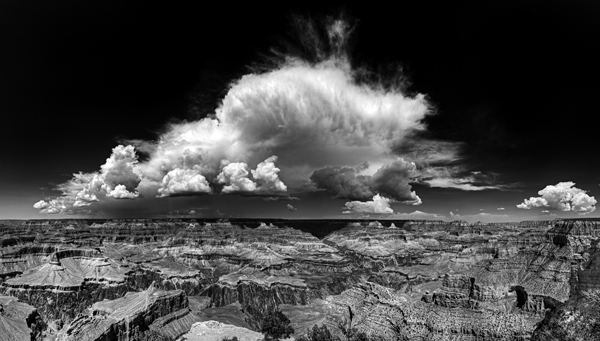Time, Space & Texture
Luke Parsons’ Landscape and Panoramic Photography Inspires Awe
His work is on display through August 25 at Petroglyphs Gallery
At first glance, Luke Parsons seems to be a man living three different lives. He’s a full-time doctoral student in geosciences at the University of Arizona studying climate change modeling. In summers, you can find him leading wilderness courses for National Outdoor Leadership School (NOLS). Year round, Parsons creates stunning art photographs. Yet a closer look reveals that for Parsons, everything is connected.
Parsons, a native of northern Arizona who moved with his family to New Mexico when he was nine-years-old, explains how his fascination with geosciences and art photography began – on family hiking trips.
“My parents started taking me backpacking at an early age in the canyon lands and mountains of Arizona and Utah. When we moved to Albuquerque, my middle school had a required photography rotation. This is where I found out I loved working in the darkroom. As I matured and participated in more outdoor trips in high school, I began to re-discover my fascination with the towering, layered Navajo Sandstone and the rippling sand dunes from my childhood backpacking trips. I was also taking geology classes, and I started making the connection between those sand dunes and the cross-bedded sandstone in the cliff walls.”
“Photographing these features,” Parsons says, “started off as a study in texture (and still is), but it took years for me to start meditating on the ‘time’ aspect that ties all of it together. When I’m in the back country, the wide-open landscapes remind me of how small and short-lived we are compared to the planet. I want to convey this sense of time and place to a viewer of my work. We fit into a larger continuing process of creation and erosion all around us.”
He pauses and adds, “I think I’m trying to capture longer than 100 years of time, trying to get people to see processes going on around them all the time. “
Although he works both in color and black and white, Parsons creates especially spectacular panoramic black and white landscapes. His dramatic Grand Canyon and Storm Clouds draws our attention to the passage of time in the canyon rocks which contrast dramatically with ephemeral clouds overhead. The same sense of time is found in Echo Canyon Towers in southeastern Arizona’s Chiricahua National Monument. Here rock formations give witness to those geological processes that long outlive human activities.
Parsons’ geology class eventually led to the study of climate change.
“In college, I started studying the history of climate and carbon on our planet, and I realized there was a whole world of study completely unknown to me that was related to the atmosphere and its effects on climate and life here on Earth. I started a research project examining the link between the strength of ocean circulation and changes in climate in North America. While teaching AP Environmental Science after college, I realized that I needed to know more about the climate system in order to be able to better communicate about climate change to both my students and the general public.”
Parsons is especially interested in helping policy makers develop better public policy using up-to-date information about the effects of climate change. His current research involves evaluating how accurate the climate change models are. Areas of public policy that he considers relevant include agriculture, water resources, energy resources, public safety and national security.
“I hope I can play a part in having a real impact on policy and people’s lives by studying and teaching about the variability of rainfall, drought and climate.” He and his colleagues have developed an explanation of climate models which can be viewed at https://sites.google.com/site/azclimatemodeling/home.
So how are we doing? How well do current models predict temperature and precipitation?
“Overall, the climate change models do a pretty good job,” Parsons says, “but it has to be an average. The models are large-scale. They can’t represent small areas like just Arizona.”
What’s the connection between his photography and his climate change research?
Parsons explains: “I worry that the wild and open places are being forgotten. I hope my photography encourages the viewer to connect with and appreciate her surroundings. I want the viewer to ponder time, the back country, or even the cacti growing up around the buildings here in Tucson. Without a connection to the outdoors and the environment, what reason does a person have to advocate for their preservation? I hope to start forming or help strengthen this connection.”
He adds, “The study of climate and the art of outdoor landscape photography are both related to close observation of the world around us. The planet has been changing for billions of years and will go on changing long after we are gone, but just as we are too busy to often notice the erosion of a stream in the Catalinas, I think we are ignoring human-induced global warming. I hope to deepen our knowledge and raise awareness about the changing planet both in my photography and in my research.”
Luke Parsons is leading an outdoor wilderness course for NOLS this month. His photography is currently on display through August 25 at Petroglyphs Gallery, 228 S. Park Ave., in the Lost Barrio. You can see more of his work at LukeParsonsPhoto.wordpress.com.
Category: Arts






